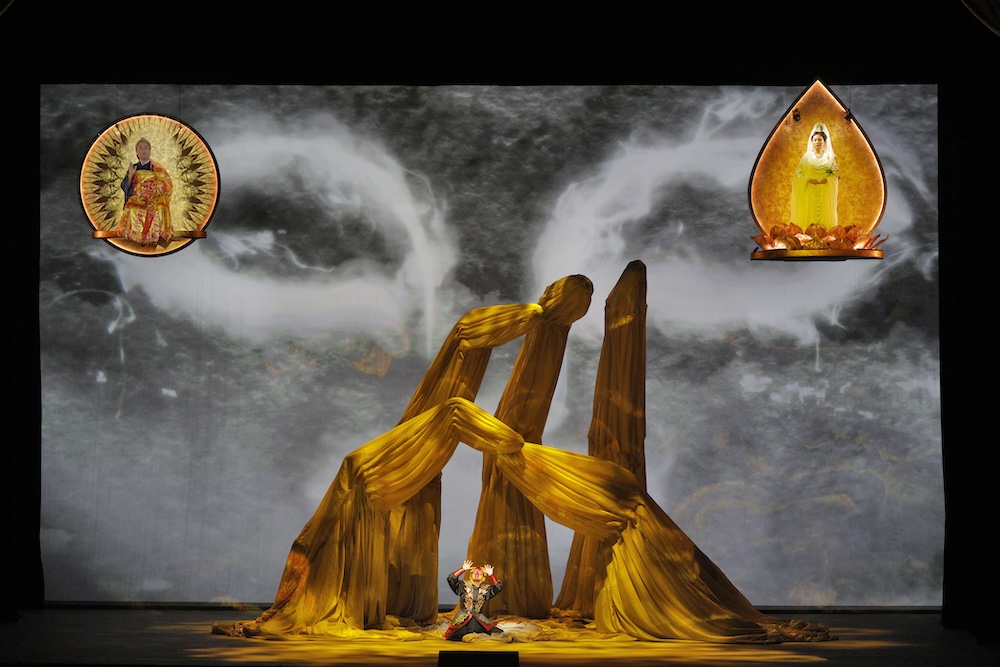A sixteenth century Chinese epic novel has found its way to the stage of San Francisco’s War Memorial Opera House just now, namely “A Journey to the West” by Ming Dynasty author Wu Cheng’en.
Its hero, the Monkey King, though, is no stranger to pop media. Already a hero, or anti hero, in video grams, a huge TV series, myriad movies and graphic novels. In this era of mass culture it was only a matter of time before he found his way onto the pop-opera stage.
The Monkey King’s creators are LA born librettist David Henry Hwang who wrote Broadway’s famed 1988 M. Butterfly, and China born, Juilliard finished, cross-genre composer Huang Ruo who composed Santa Fe Opera’s 2022 M. Butterfly to Mr. Hwang’s libretto (based on his play),
In The Monkey King they have wished to create an opera culture that is neither Eastern nor Western — a theater based on the intersecting of the world’s contemporary cultures, their internal influences, and not least, digital theater technology.
San Francisco Opera’s (and the Chinese Heritage Foundation of Minnesota’s) The Monkey King is a music theatre piece with the antics of a video game, the flash and spectacle of a Broadway musical, the pedigree of a literary classic, a combination of ancient and state-of-the-art theater practices, and the blunt, basic story telling of a graphic novel, etc. Its music is unconstrained by any sense of historical form, or any form for that matter. It is free flow of orchestral colors and textures that tirelessly embellish the texts of songs and chants of the story, often lapsing into minimalist repetitive structures.

The orchestra is double winds and brass, plus strings, though colored by a pipa (Chinese lute) and a battery of Chinese gongs and cymbals played by two percussionists. Composer Huang creates a huge palette of colors, dark and bright, intimate and massive, calm and agitated — a palette well matched to the graphic novel (comic book) esthetic of the piece. Characteristic Asian intervals and western harmony are not perceived.
The story told in The Monkey King is only the first few chapters of full novel’s one hundred. Sun Wukong, the Monkey King, who has been imprisoned for 500 years, claims that he is handsome and traces, in flashback, his life from birth (hatched from a stone) to his becoming the savior of the monkeys. He follows his progress from fool to enlightenment through a series of encounters with Master Subhuti and various other kings and forces. He is watched over by the airborne spirit Guanyin, confronted ultimately by Buddha himself, and finally shackled by the Diamond Sutra in the form of a belt (the Diamond Sutra is a famed fifth century dialogue tract between Buddha and Master Subhuti).
Zen Buddhism meeting grand opera may be uneasy alliance, but it had a flashy outcome indeed at the hands of famed music theater stage director Diane Paulus who worked with puppetry and set designer Basil Twist, choreographer Ann Yee, Hong Kong born costume designer Anita Yavich,
Brooklyn lighting designer Ayumu “Poe” Saegusa, Korean born projection designer Hana S. Kim. All Mme. Paulus’ collaborators have created special niches for themselves in either the opera/musical theatre world or the fringe theater world.
The resulting production was spectacular, I.e. filled with spectacle. Filmy drapes flew up and down and around, changing colors as they flowed, Guanyin (the Monkey King’s guardian) and Buddha flew through the upper reaches of the stage picture in suspended gondolas, there were grandiose puppets (especially the white horses — lead photo, with Kang Wang as the Monkey King), brilliantly colored monkey, courtesan, and monk choristers. There were dragon processions, streamers streaming on poles moved by Kabuki theater’s kurokos, the same black clad, invisible people who moved the Monkey King puppet.
Episode followed episode.
The Monkey King was not only a cute puppet — with his dual ostrich feather plumes identity — who appeared from time to time, he was tenor Kang Wang (a Metropolitan Opera Alfredo), and he was a dancer as well in the person of Huiwang Zhang (who danced in Santa Fe Opera’s M. Butterfly). Beyond fine singing Mr. Wang was an accomplished mime who moved nearly as nimbly as his dancer double, who leapt and flipped in grand, circus style.

Several singers in the cast had been part of San Francisco Opera’s 2016 Dream of the Red Chamber (libretto by David Henry Hwang) — the Guanyin role was sung by China born soprano Mei Gui Zhang, evidently fearless in her flying gondola. Mlle. Zhang was also the beautifully voiced Euridice, a cameo role in San Francisco Opera’s Orfeo ed Euridice. The puppet Crab General was sung by China born mezzo-soprano Hongni Wu, who sang the Venus Star as well. Mlle. Wu sings Rosina in San Francisco Opera’s upcoming Barber. Korean tenor Konu Kim who sang the Jade Emperor sang Glyndebourne’s Ferrando in Cosi.
The prestigious casting included Vienna State Opera bass-baritone Jusung Gabriel Park as both Master Subhuti and Buddha. San Francisco Opera’s Sparafucile, bass Peixin Chen was the Supreme Sage Laojun, and SF Opera’s Ping, Joo Won Kang was the Dragon King.
Conductor Carolyn Kuan, music director of the Hartford [CT] Symphony, held the orchestral, choral and solo forces well in tow. Ma. Kuan conducted composer Huang Ruo’s M. Butterfly in Santa Fe, as well as his An American Soldier for New York’s American Composers Orchestra.
It was a long, very long two hours twenty minutes at the War Memorial Opera House.
Michael Milenski
War Memorial Opera House, San Francisco, November 26, 2025.
All photos copyright Cory Weaver, courtesy of the San Francisco Opera